|
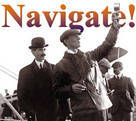
 Up
Up 
 Resolution
Resolution

(You are here.)
 Down
Down




  Need
to Need
to
find your
bearings?
Try
these
navigation aids:
If
this is your first
visit, please stop by:
Something
to share?
Please:



|
|
Available in Française, Español, Português, Deutsch, Россию,
中文,
日本, and others.
 n
the end it was politics – or at least political
considerations – that finally resolved this stand-off. In early
1942, Fred C. Kelly contacted Charles Abbot to tell him that he was
writing the first authorized biography of the Wright brothers. As
part of Kelly’s agreement with Orville Wright, he was to do what he
could to resolve the differences between the Smithsonian and the
Wrights. Abbot’s first reaction was to tell Kelly how much grief
this problem had cost him. Then, for four months, he voiced the same
objections and opinions that he had raised when Lindbergh and others
had attempted to negotiate a settlement. n
the end it was politics – or at least political
considerations – that finally resolved this stand-off. In early
1942, Fred C. Kelly contacted Charles Abbot to tell him that he was
writing the first authorized biography of the Wright brothers. As
part of Kelly’s agreement with Orville Wright, he was to do what he
could to resolve the differences between the Smithsonian and the
Wrights. Abbot’s first reaction was to tell Kelly how much grief
this problem had cost him. Then, for four months, he voiced the same
objections and opinions that he had raised when Lindbergh and others
had attempted to negotiate a settlement.
Kelly, however, brought two things to the table
that hadn’t been tried before – a sense of humor and an
exceptionally perceptive understanding of human behavior. In
addition to being an accomplished journalist and biographer, Kelly
was also a humorist and had written books and articles on the
psychology of economics. Kelly’s letters to Orville were playful and
those to Abbot were unfailingly respectful. He did not confront
either man and as a result earned the trust and friendship of both.
Abbot cut off the conversation at one point, but Kelly was patient
and eventually brought him back.
Abbot himself must have felt tremendous
pressure. An authorized biography would have a shelf-life measured
in eons, and Kelly wasn’t shy about telling Abbot that it would
have an entire chapter dedicated to the tale of the
Wright/Smithsonian controversy. The invention of the airplane was a
matter of national pride, the exile of the Wright Flyer in England
was a continuous embarrassment for the Smithsonian, and the Board of
Regents wanted to end it. On the other hand, the Board also wanted
to avoid the embarrassment of admitting the Smithsonian’s error. In fact Frederick C. Walcott, Charles
Walcott’s nephew, was on the board and did not want to see his
uncle’s name disparaged. Additionally, Albert Zahm – who was now
responsible for the aviation section of the Library of Congress –
was in the loop and anxious to preserve his own reputation. If all
this wasn’t pressure enough, Abbot knew that Orville was an old
man. If Abbot didn’t write a better ending to the tale now, he
might never get another chance.
In the summer, Abbot stopped blustering, put pen to paper, and began
to work out what he might publish that would end the conflict. ”He
seems desperate to satisfy you,” Kelly wrote to Orville. Nonetheless
Abbot was slow to respond to Kelly’s suggestions and Orville’s
demands, probably because he had to run any response past the Board
of Regents. But the two parties inched towards an agreement. In
August, Abbot requested Kelly come to Washington for two long
face-to-face sessions in which they hammered out the details. Abbot
balked on small points, particularly concerning Walcott and Zahm,
but Kelly was good-natured and insistent. By the end of September,
Walcott sent Orville what he hoped was the final version of the
apology that he would publish in the Smithsonian Miscellaneous
Reports. “I judge that he has completely caved in,” Kelly wrote to
Orville.
When Orville
and Abbott next met at a NACA meeting on 23 October, Orville was “as
happy as a schoolboy over the outcome,” Abbot told Kelly. All seemed
forgiven, but there was one more hiccup. Three days later, the
Smithsonian published “The 1914 Tests of the Langley ‘Aerodrome’”
which listed every change made to the Aerodrome prior to its test
flights and apologized for the misinformation the Smithsonian had
published on this matter, and said in plain language, “The flights
of the Langley Aerodrome at Hammondsport in 1914…did not warrant
statements published by the Smithsonian Institution that these test
proved that the Langley machine of 1903 was capable of sustained
flight carrying a man.” Unfortunately Abbott, without consulting
Kelly or Orville, had made some minor changes right before
publication, adding comments about the list of changes to the
Aerodrome and Langley’s 1896 flights. This angered Orville.
Fortunately,
Kelly stepped in before Orville could confront Abbott. He talked
Orville down, pointing out that the media had received the news of
the Smithsonian’s apology very well and were already celebrating the
end of the feud. The New York Times, in an article titled “An
Air Quarrel Ended,” summed it up this way: “Dr. Abbott’s sweeping
repudiation of past Smithsonian claims cannot remake history, but so
generous an acknowledgement should end old estrangements." The editor
ended with this hopeful plea: “Perhaps Orville Wright will now bring
the Kitty Hawk plane home to the United States, where it should rest
forever.”
Orville held his
tongue and agreed to bring the Flyer back from England. In fact,
Orville very graciously buried the hatchet after the release of
Kelly’s book, “The Wright Brothers: A Biography Authorized by
Orville Wright,” in May 1943. The book contained a copy of
Abbott’s apology of 26 October 1942, giving it much wider
distribution than it might have had otherwise. Orville wrote to
Abbott, “I can well understand the difficult position you found
yourself in when you took over the administration of the Institution
at a time when it had on its hands an embarrassing controversy for
which you were not responsible, so I appreciate the more your effort
to correct the record of the tests at Hammondsport in 1914 which
brought on that controversy.”
Orville and Abbott had intended to
share the good news about bringing the Flyer home with the
publication of the 1942 Smithsonian Annual Report, due to be
released in the summer of 1943 and containing yet another copy of
Abbott’s apology. But they were delayed by one more round of
politics. Every year since he had come to office in 1933, President
Franklin D. Roosevelt had sent a congratulatory note to Orville on
the date of the first powered flights at Kitty Hawk. This year would
mark the fortieth anniversary of those flights and Roosevelt asked
to make the announcement himself at a White House dinner on 17
December 1943 where the annual Robert J. Collier Trophy (for
excellence in aeronautics) would be awarded. Orville and Abbott
agreed, and Orville wrote Col. Ernest Mackintosh, the director of
the Kensington Science Museum on 8 December 1943 to inform him of
the decision to bring the Flyer back to America. “I think you will
not be surprised in learning of this decision,” wrote Orville. “But
I wish to let you know of it before the public announcement is
made.”
As fate would
have it, Roosevelt was unable to attend his own event.
He had recently been diagnosed with congestive heart failure, a
state secret of which Orville and Abbot were unaware. As 17 December
dawned, the president had just returned from the Tehran Conference,
the first of the "Big Three" meetings between Roosevelt, Stalin, and
Churchill. Due to his deteriorating condition, the president was
dangerously exhausted by the 7,000-mile journey.
Orville, unaware of the president's
infirmity, was understandably upset and refused to speak when
it came time for him to present the Collier Trophy to General Hap
Arnold. He simply handed the envelope that contained the certificate
of award to the general and sat down. But Arnold
covered Orville’s silence graciously with a witty remark.
Roosevelt’s words were read by Secretary of Commerce Jesse Jones.
To an audience
that included not only Hap Arnold, but also Eddie Rickenbacker,
Roscoe Turner, Igor Sikorsky, Glenn Martin, Grover Loening and other
aviation greats, Jones read Roosevelt’s summary of aviation’s
“contribution to the progress of man” in war and peace. “All of
these achievements and all of these hopes stem from the first Wright
plane, whose basic principles still govern flying…The nation will
welcome it back as the outstanding example of American genius.”
In
Their Own Words
Which Leaves Just
One Final Question
-
Could the
1903 Langley Aerodrome Have Flown?
– Abbot's apology and retraction said nothing about the
Aerodrome's airworthiness in 1903, only that the Smithsonian no
longer believed that the 1914 experiments at Hammondsport proved
the Aerodrome could have flown in its original configuration.
The question remains: Could Langley's Great Aerodrome flown in
1903?
More Information
-
The Smithsonian Contract
– Orville died before the Wright Flyer could be installed in the
Smithsonian, and the executors of his estate, mindful of the
long feud between Orville and the Smith, thought it would
be in his best interests to establish a contract between the
Smithsonian and the Wright Estate. This agreement defined how
the Flyer would be displayed and what would happen if the
Smithsonian backslid and again designated the Aerodrome A
– or any other aircraft
– as the first capable of sustained manned flight. The
"Smithsonian Contract" has since become controversial.
|
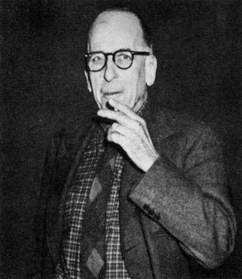
Fred C. Kelly profiled many prominent Americans during his long
career as a journalist, columnist, and humorist. He began
corresponding with Orville Wright in the late 1930s.
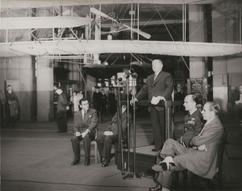
George Tomlinson, the British Minister of Education speaking at the
Science Museum in Kensington, announces that the Wright Flyer will
be going home. Although the museum was notified in 1943, the Flyer
remained in England until World War II was over and it was safe to
travel. The Science Museum was also given time to make a precise copy
of the aircraft.
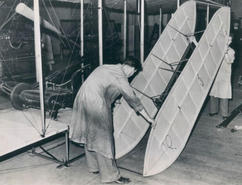
The Science Museum staff packs up the 1903 Wright Flyer.
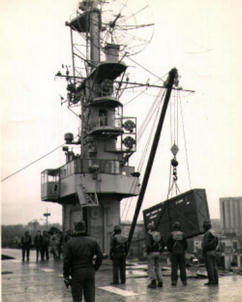
The crated Flyer is unloaded from the escort carrier USS Palau
(CVE-122) in Norfolk. VA in 1948. It crossed the Atlantic aboard the
RMS Mauretania, then was transferred to the Palau at Halifax, Nova
Scotia.
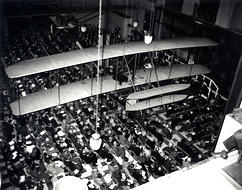
The unveiling of the 1903 Wright Flyer in the North Hall of the Smithsonian Arts and
Industries Building on 17 December 1948 – the 45th anniversary of
the first flights.
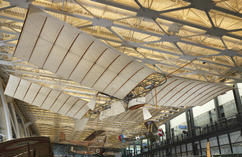
The 1903 Langley Aerodrome is now exhibited at the Smithsonian Udvar-Hazy
Annex near the Dulles Airport outside Washington DC.
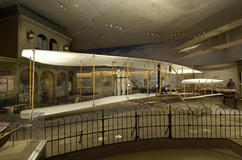
The 1903 Wright Flyer is exhibited at the Smithsonian Air and Space
Museum on the Mall in Washington DC.
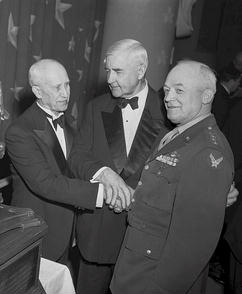
Left to right – Orville Wright, Secretary Jesse Jones, and General
Henry "Hap" Arnold in an awkward three-way hand shake at the Collier
Trophy Award ceremony on 17 December 1943. This is probably the
happiest that Orville looked all night. (Courtesy Franklin D.
Roosevelt Presidential Library.) |